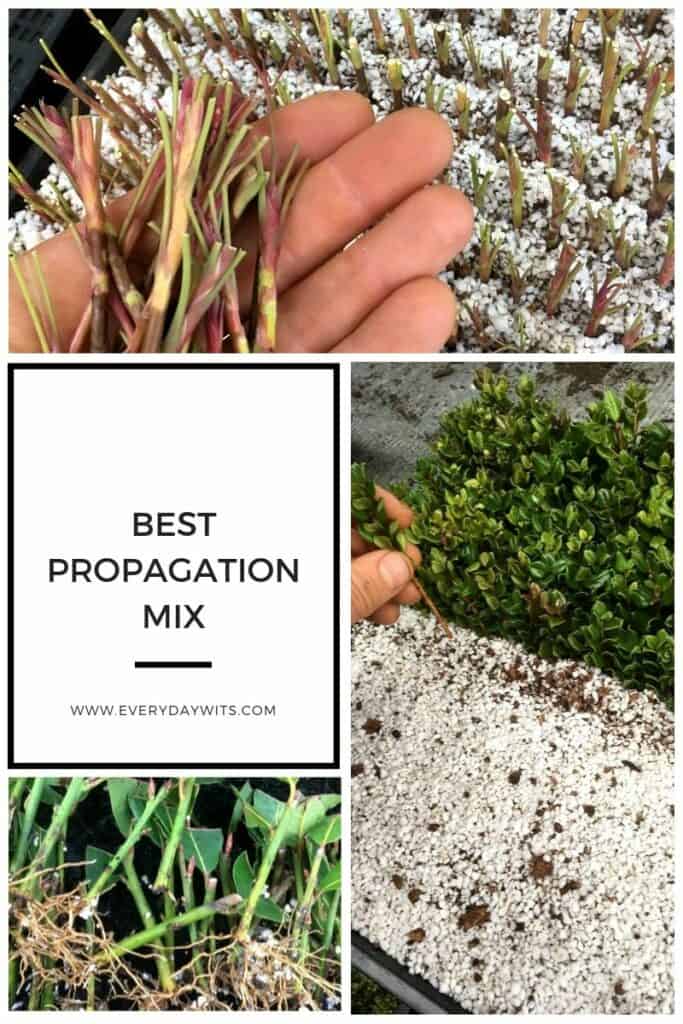A common question we get asked is what is the best propagation mix for striking cuttings? There are quite a lot of options but for us and many professional plant growers a mix using predominantly perlite is best.
We propagate around 30,000 plants each year the majority of which are done via cuttings. Petra and I have been propagating plants for almost 20 years now. During that time we’ve had the opportunity to trial different propagation mixes and have concluded that a majority perlite mix is easily the most cost effective and successful propagation medium.
Check out our propagation page to view all the different plants we propagate with the exact methods we use.

Why is perlite so effective for cutting propagation?
1. Perlite is an inert and sterile. This is perfect for those of us propagating plants as we aren’t going to bring in any unwanted pathogens and diseases.
2. Perlite is pH neutral which is perfect for the propagation of most plants.
3. The water retention capabilities of perlite are perfect for cuttings. It will drain away any excessive moisture but holds enough to promote root development.
4. Perlite will not deteriorate overtime and this allows oxygen to flow through the gaps which is great for root development.
5. Perlite is available in a variety of “grades” or sizes.
6. Perlite is a natural product.
7. Perlite is a volcanic rock and can be safely used on heating mats which provide bottom heat to the developing roots- very effective for improving cutting success rates and propagating plants during winter.
What exactly is perlite?
Perlite is a volcanic glass. The stuff we buy for plant propagation has been heated up in a kiln. It explodes at high temperatures to produce the small light weight pieces that we buy.
Perlite can be found all over the world and is cheap to purchase. Unlike other propagation media it will not compact over time. Providing oxygen to roots is very important. Without oxygen anaerobic pockets form and these are breeding grounds for unwanted bacteria’s and diseases.
The dust from perlite shouldn’t be inhaled and we wear a mask to prevent breathing in the dust. Wetting it down before handling will greatly reduce the amount of dust.
Do we add anything else to the perlite to improve it?
Yes, we add a small amount of peat moss. Our go to propagation mix is 90% perlite 10% peat moss.
Peat moss is another natural product that is neutral in pH and holds water really well. And that’s why we add a small amount to our perlite. Peat moss holds water better than perlite and this is helpful once the roots begin to develop.
Once the roots “strike” the cuttings will begin to consume the moisture. Providing the peat moss helps prevent the mix from rapidly drying out.
Perlite vs vermiculite
For many years vermiculite was the medium of choice for professional propagators. Vermiculite is very similar to perlite in that its inorganic and light weight. Both are heated at high temperatures to create the product we use. Both will not break down or rot overtime.
Vermiculite is able to hold much more water than perlite. While some may find that a positive for plant propagation, we find too much water can be very detrimental to cutting success rates.
Rot and fungal growth can be a problem when trying to strike plants from cuttings. Especially cuttings that take a longer period of time to strike roots.
Because vermiculite holds so much water it doesn’t allow the airflow to the root zone as perlite does. Good oxygen flow provides a much healthier and stronger root system.
Perlite will hold some moisture but will not become water logged. Perlite is free draining and very difficult to overwater.
The benefits of the added airflow and draining ability are enough to make perlite a better choice of medium for striking cuttings.
What does perlite cost?
We pay $40- for 100 Litre(26.5 US Gal) bags. 100 Litres works out to approximately 10kg (22 lbs) Of course this is purchased in bulk.
Smaller quantities can be purchased on amazon and eBay. These smaller quantities are still quite cost effective for the home propagator.
Remember to re-create the same mix we use add a small amount of peat moss.
Other propagation mixes
Sand– Adding sand to propagation mixes or using sand itself was once a very common occurrence, not so much any more. Obviously sand is quite cheap and readily available. The solid grains allow for good air circulation. When mixed with peat moss or potting soil it can provide an effective propagation medium.
The downside of sand is that it’s poor at holding moisture and can contain germs, bacteria’s and organisms that can be problems for cuttings.
Straight potting mix- We like to use straight potting mix on cuttings that are really fast to “strike” roots. This allows us to save time in the long run as we don’t need to repot the cuttings. Most potting mixes contain good amounts of organic materials which will retain moisture and provide nutrients to the plants. They also contain inorganic materials like sand that will not break down and provide improved drainage as well as airflow.
The cons of using a straight potting mix is the risk of pathogens within the soil.
Vermiculite– As mentioned vermiculite is a very popular propagation media. It’s inert, pH neutral and sterile. Vermiculite has superior water retention capacity.
The downside is it’s fantastic water holding capacity. When it becomes waterlogged it starved the roots of oxygen which will kill many, though not all plants.
Peat moss– As I’ve said we mix in a small amount of peat moss with our perlite but some people will propagate plants in pure peat moss. This can be effective but we only recommend that for plants that really really love moisture. Peat moss is a lot like vermiculite in that it holds moisture almost too well.
Peat moss should be mixed with other propagation media to reap the full benefits. Adding sand or perlite to aid in drainage and oxygen availability.
Other posts that may interest you
For full tutorials on all the plants we propagate in our nursery check out the propagation page. And if this kind of stuff interests you check out our articles on how to start a plant nursery and our income from our plant nursery. Also subscribe to stay up to date with our content.
